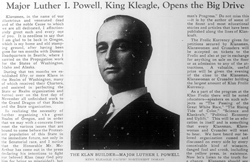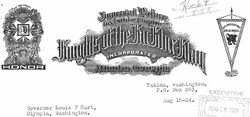“Major” Luther Ivan Powell founded the Washington State Ku Klux Klan in 1922. He also organized Klan chapters in California, Oregon, and later Idaho, Alaska, and Montana.
A native of Shreveport, Louisiana, Powell began organizing for the Klan on the West Coast in California in 1920.1 But it was in Oregon that his efforts took off. Beginning in early 1921, he founded Klan chapters in Medford, then in Klamath Falls and Roseburg. More important was the large chapter he started in Portland in February, 1922. Honoring its founder, it was chartered as Luther Powell Klan No. 1.2 While Oregon’s Klan membership mushroomed, Powell himself lost his bid against Fred Gifford to lead the Oregon Klan and moved to Seattle in 1922 to organize new chapters in Washington and Idaho.3
Powell’s organizing strategy relied heavily on using the membership lists of “fraternal, civic, and social” groups, especially anti-Catholic organizations such as the Freemasons, and recruiting those already involved in ritualistic secret societies into the Klan.4
As King Kleagle of Washington and Idaho, Powell was the most prominent leader and spokesperson of the state Klan in 1923. He founded Seattle Klan Local 4 in 1922 with 2,000 members.5 He founded and edited The Watcher on the Tower, a weekly magazine that spread Klan propaganda while generating further income for his organizing. He was also able to organize a chapter of Navy servicemen stationed abort the U.S.S. Tennessee in the Puget Sound.6 And in August of 1923, he founded the Junior Knights of the Invisible Empire, an unsuccessful KKK youth organization founded at roughly the same time that the national KKK created the Juvenile Knights of the Ku Klux Klan.7
While Powell was able to organize dozens of Klan chapters in less than a year, his personality undermined his accomplishments. He was a controversial character prone to outlandish exaggeration and constant squabbles for power with other Klan leaders, especially in Oregon. This was not unusual for the Klan at the time, and is one of the reasons cited for its rapid collapse. The Klan’s extraordinary growth in the early 1920s came through aggressive marketing driven by organizers like Powell who fought like competing salesmen. Such infighting, along with constant appeals for money, left many rank-and-file members feeling used, fleeced, or both.
In the Fall of 1923, Powell left Seattle in an attempt to reassert power within the Pacific Northwest Klan. In September of 1923, Oregon Klan leader Fred Gifford appointed CC Curtis of Vancouver, Washington (located across the river from Portland) to be the provisional Grand Dragon of all Washington State chapters.8 Whether this followed Powell’s departure or is what pushed Powell out of Washington is unclear. After Powell left, the Watcher on the Tower started reprinting the same articles in multiple issues, and it soon folded altogether, though the Klan continued to grow until its implosion following the November, 1924 election. Powell failed on his promise to create a 50,000 member Klan chapter in Portland, was again pushed out of Oregon, and announced plans to organize Klan chapters in Alaska and Hawaii (the results of which are unknown).9
He was also active in British Columbia. On October 30, 1925, the Klan held a large parade through the streets of Vancouver, BC. Soon after, the Canadian government barred Luther Powell from entering the country. After being stopped at the border, Powell briefly resided in the border town of Blaine, Washington, near the strong Klan chapters in the Bellingham area.10 Canadian authorities meanwhile gathered information about his activities. One critic of the Klan charged that Powell was greedy as well as a troublemaker:
This scheme is to try and get as much money as he can by organizing the Ku Klux Klan. They worked Oregon out and when the field became too tame for them now seek their work of destruction in BC. Powell and his followers caused trouble in Oregon and injured our State to the extent that it will take years to regain Oregon’s good name. Powell is devoid of common decency and can do nothing but harm in the place of my birth, BC.11
At some point around this time, the Vancouver chapter of the KKK that Powell organized expelled him, and members of a Klan chapter in Victoria reportedly asked local officials to deport him.12
Powell later returned to Louisiana, where he became a leader in a fringe, right-wing organization called the Khaki Shirts of America. A police officer in Shreveport in the 1930s wrote that Powell’s reputation in Shreveport is far from good.
He has lived by his wits for many years– in fact, I have never known him to do any work. He pays no bills, and he is a man utterly without standing in the community. He presents a good superficial appearance and is a good speaker, and in that way he got control of the organization known as the Khaki Shirts of America. I am reliably informed that his misuse of the funds of the organization was the primary cause of its disbandment… I am… certain that no organization sponsored by Powell could make any headway here because Powell has neither the respect nor the confidence of anyone who knows him.13
After leaving the Khaki Shirts, Powell became an organizer for William Dudley Pelley’s fascist organization, the Silver Shirt Legion of America (or Silver Shirts), which occasionally brought him back to the Northwest. He was not alone in making this transition. Powell’s former KKK rival in the Northwest, Fred Gifford, also joined the Silver Shirts in 1933 in an attempt to revive his largely moribund “invisible empire” in Oregon. Neither was successful. Gifford left the Silver Shirts of his own accord in 1935. Powell, however, was demoted by Pelley when Powell unilaterally fired a Pelley organizer in Portland in an attempt to seize control of the entire state organization. Instead of remaining in the Silver Shirts following his demotion, Powell moved to Texas to supposedly lead the Anti-Communist Legion of the World, about which little is known.14
Though a number of Silver Legion members were former Klansmen, it’s unclear what role Powell had in that transformation in the Northwest. But his career showed how the Klan’s politics of Christian patriotism and white supremacy, while claiming to be democratic, could lead to American fascism.
Next: Ch 3, The Ku Klux Klan in Seattle
“The Washington State Klan in the 1920s” by Trevor Griffey includes the following chapters:
- Citizen Klan: Electoral Politics and the KKK in WA
- Luther I. Powell, Northwest KKK Organizer
- The Ku Klux Klan in Seattle
- The Strongest Chapter in WA: Bellingham’s KKK
- The Ku Klux Klan and Vigilante Culture in Yakima Valley
- KKK Super Rallies in Washington State, 1923-24
- Social Klan: White Supremacy in Everyday Life
- The Washington State KKK and the U.S. Navy
- Non-Citizen Klan: Royal Riders of the Red Robe
Copyright (©) Trevor Griffey 2007
1 Kenneth T. Jackson. The Ku Klux Klan in the City, 1915-1930. New York: Oxford University Press, 1967. p 196; J. Kingston Pierce.Eccentric Seattle: Pillars and Pariahs Who Made the City Not Such a Boring Place After All. Pullman, WA: Washington State University Press, 2003. p. 215
2 Jackson, p. 196-7
3 David Chalmers. Hooded Americanism: The History of the Ku Klux Klan. Chicago: Quadrangle Books, 1968. p. 216
4 Jackson, p. 197. Penelope McMullen. “Popular Reaction to Ku Klux Klan Activity: Washington State, 1924 Elections.” Unpublished undergraduate Skidmore College paper, 1995. pp. 2-3
5 Jackson, p. 194
6 “The Story of the Klan on the Tennessee.” Watcher on the Tower, July 28, 1923, p. 5
7 “Powell Becomes National Head of Junior Knights of the Invisible Empire.” Watcher on the Tower, August 18, 1923, p. 2
8 “Editorial Notice.” Watcher on the Tower, Sept. 15, 1923. p. 8
9 Jackson, p. 211. Chalmers, p. 219. “Powell and Davis May Return to Hawaii—Good Season Ahead for Propagandists.” Watcher on the Tower, Oct. 20, 1923, p. 13
10 “Klan Organizer Refused Entry by Canadians.” Los Angeles Times (1886-Current File); Nov 14, 1925; ProQuest Historical Newspapers Los Angeles Times (1881 - 1985) p. 1
11 Superintendent of Provincial Police, “Superintendent of Provincial Police Regarding KKK,” November 13, 1925. Selkirk College, KCIR Cabinet, BC Attorney General, GR 1323, File P-130-38-1925 Ku Klux Klan Reel B 2213. Accessed on 7/18/07 via //www.canadianmysteries.ca/sites/verigin/suspects/kkk/1740en.html
12 A.M. Manson, “Letter to Thomas Mulvey from A.M. Manson Regarding KKK,” February 4, 1926. Selkirk College, KCIR Cabinet, BC Attorney General, File P-130-38-1925 Ku Klux Klan Reel B 2213. Accessed 7/18/07 via //www.canadianmysteries.ca/sites/verigin/suspects/kkk/1742en.html
13 Donald S. Strong. Organized Anti-Semitism in America: The Rise of Group Prejudice During the Decade 1930-40. Washington, DC: American Council on Public Affairs, 1941. p. 48
14 David A. Neiwert. In God’s Country: The Patriot Movement and the Pacific Northwest. Pullman, WA: Washington State University Press, 1999. pp. 45-46; Karen E. Hoppes. “William Dudley Pelley and the Silvershirt Legion: A case study of the Legion in Washington State, 1933-1942.” Unpublished PhD Dissertation, CUNY, 1992. p. 120


